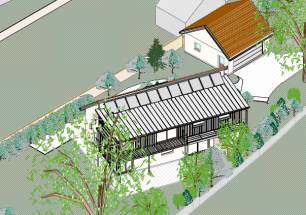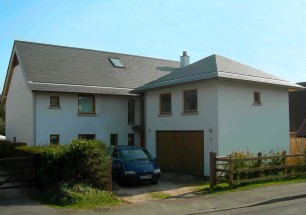New three bedroom detached house in an urban setting
The site is situated within a well developed housing area down an unmade road serving a number of houses. The site was originally part of the owner’s garden. The house design was originally by Ollie Burchall but was developed into a Passivhaus project by this practice with some adjustments to the layout and configurations. The house has the first floor partially within the roof space with lower wall heights at the eaves which partially compensate for the large open volume at the centre of the house. This area is well lit by roof windows to both side elevations. The orientation of the site does not allow for the main facade to be south-facing but the distribution of the external doors and windows and sizing alleviate some of the disadvantages. The original design also incorporates a single storey section to a reduced width against the main block of the house. The additional wall and roof areas and the central volume give a higher potential heat loss than would be ideal but the PH15 (Passivhaus Homes Ltd.) construction system used for the timber framed external envelope allows for a greater thickness of woodfibre cladding to the outside of the frame which has mitigated most of the greater heat loss.
The house has high levels of insulation and airtightness as well as whole house mechanical ventilation with heat recovery (MVHR) all of which contribute to the very low energy requirements. The energy used by the house is offset by a considerable number of solar panels to the house and garage roofs backed up to battery storage for use in the house and to run an air source heat pump which provides the domestic hot water.
The impact of the house on the site is also reduced by the provision of a rain water harvesting system using an underground tank which provides water to the house for toilet flushing and clothes washing as well as car cleaning and garden watering thus reducing the water requirements for the house.
The materials have been selected to relate to the surrounding area, most notably the rendered walls of the adjacent house are echoed in most of the external walls but with some areas of boarding to provide visual relief. The boarding is a timber based composite which reduces the long term maintenance requirements and the short term uneven fading of natural timber. Natural slates have been selected to provide a quality finish to the house and garage roofs. The solar panels are integrated into the roof finish reducing the number of slates required which reduces the cost of supplying and installing these which offsets some of the cost of the solar installation.
The project is now completed and recently certified to the Passivahus Plus standard.













